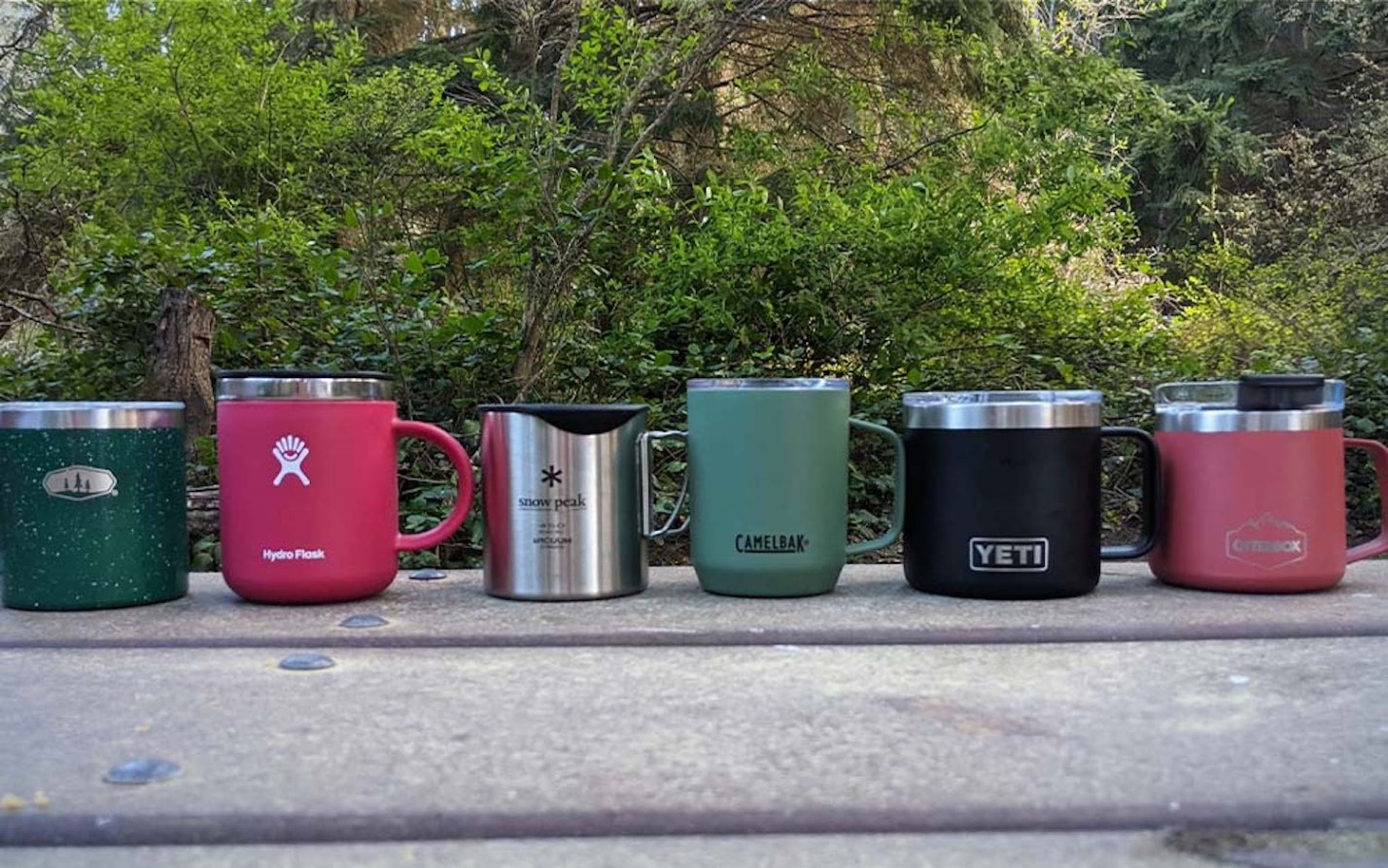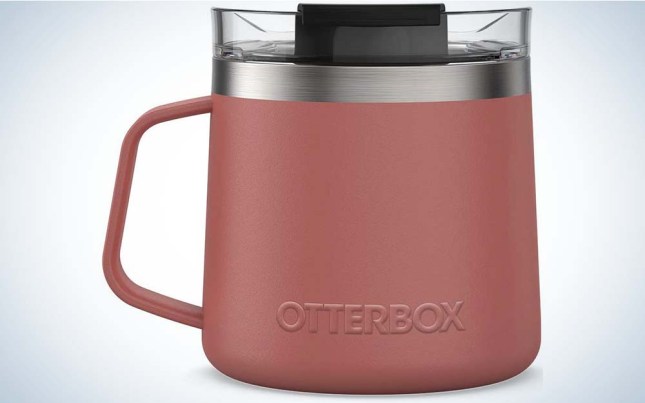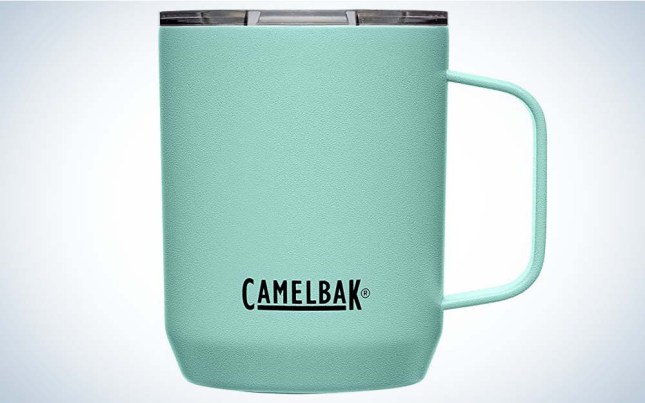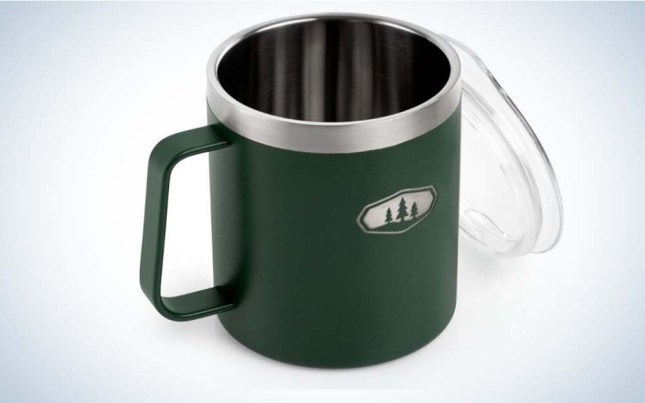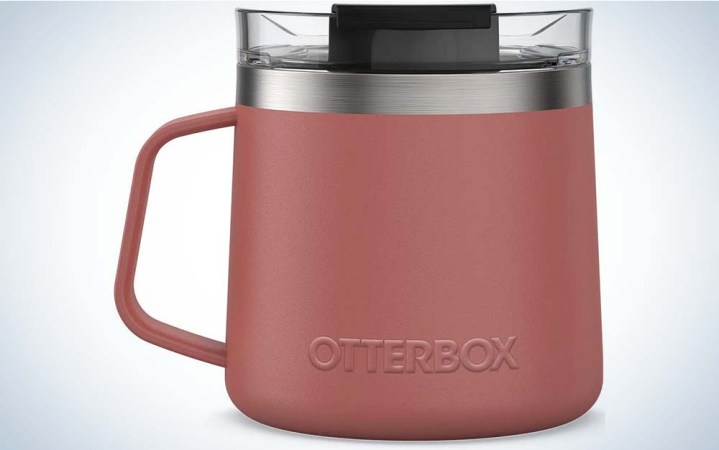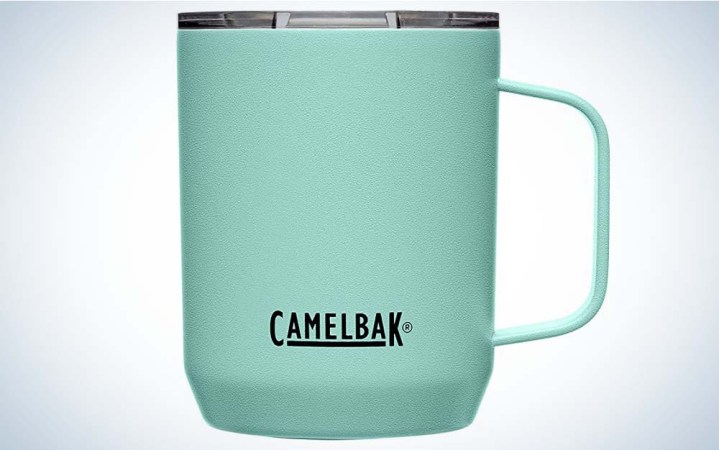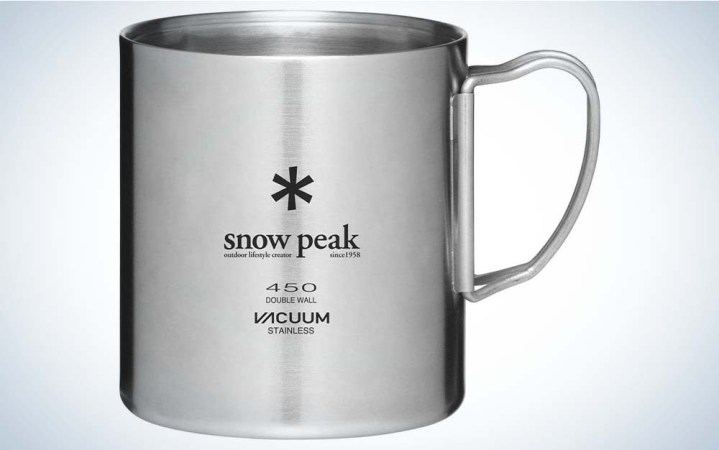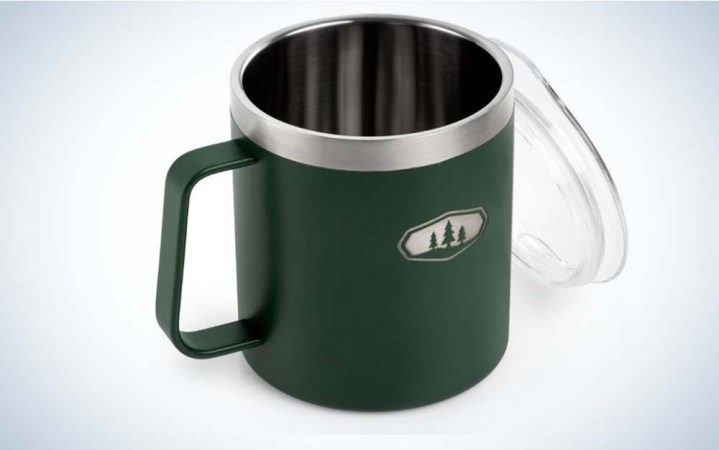We may earn revenue from the products available on this page and participate in affiliate programs. Learn More ›
Your old blue enamel camping mug had a good run. It was humble and trustworthy—only a few chips to show for those years at the bottom of your camping gear box. But, somehow, your coffee always seemed to be either too hot to drink or already lukewarm—so it’s time to say farewell. Because today, the best camping mugs are double-walled, vacuum-insulated, and they can keep your brew warm all morning. I put six of the most popular options through a series of tests to evaluate each mug’s insulation, seal, flavor leaching, and ease of cleaning. After testing, only four of the six mugs made the final cut to be included in the best camping mugs list.
- Best Overall: OtterBox Elevation
- Best Insulation: CamelBak Horizon Camp Mug
- Best Minimalist: Snow Peak Stainless Steel Camping Mug
- Best Budget: GSI Outdoors Glacier Camp Cup
How I Tested the Camping Mugs
To determine the best camping mugs, I started with a series of controlled tests. First, I ran an insulation test to see how long it took for a single cube to melt inside of each camping mug, running this test in parallel to ensure temperature and light exposure were consistent. I then repeated this process to confirm the results.
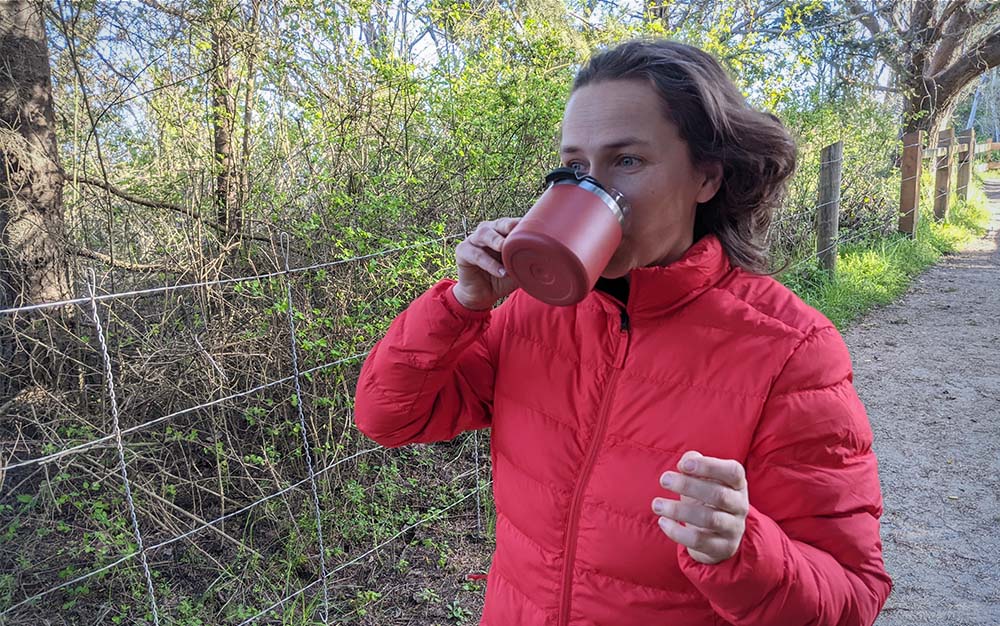
Next, I checked the seal of the mugs by filling them with liquid and holding them at an angle to see how much leaking there was. I then left filtered water in each mug overnight to ensure that there were no unwanted tastes the next day (all the mugs passed this test with flying colors). I also confirmed the weight and capacity of each mug; as such, there are some differences from the manufacturer specifications.
Next was a field test—all six mugs in the test came on a 3-day camping trip in April, which saw near-freezing temps and rain. During that test, the mugs were evaluated for comfort and functionality. After use, all six mugs were left with the coffee residue inside for several days before the final test, to see how difficult each mug was to clean.
Finally, I confirmed with each manufacturer the material used in the camping mug, as well as whether these materials were BPA, BPF, and BPS free.
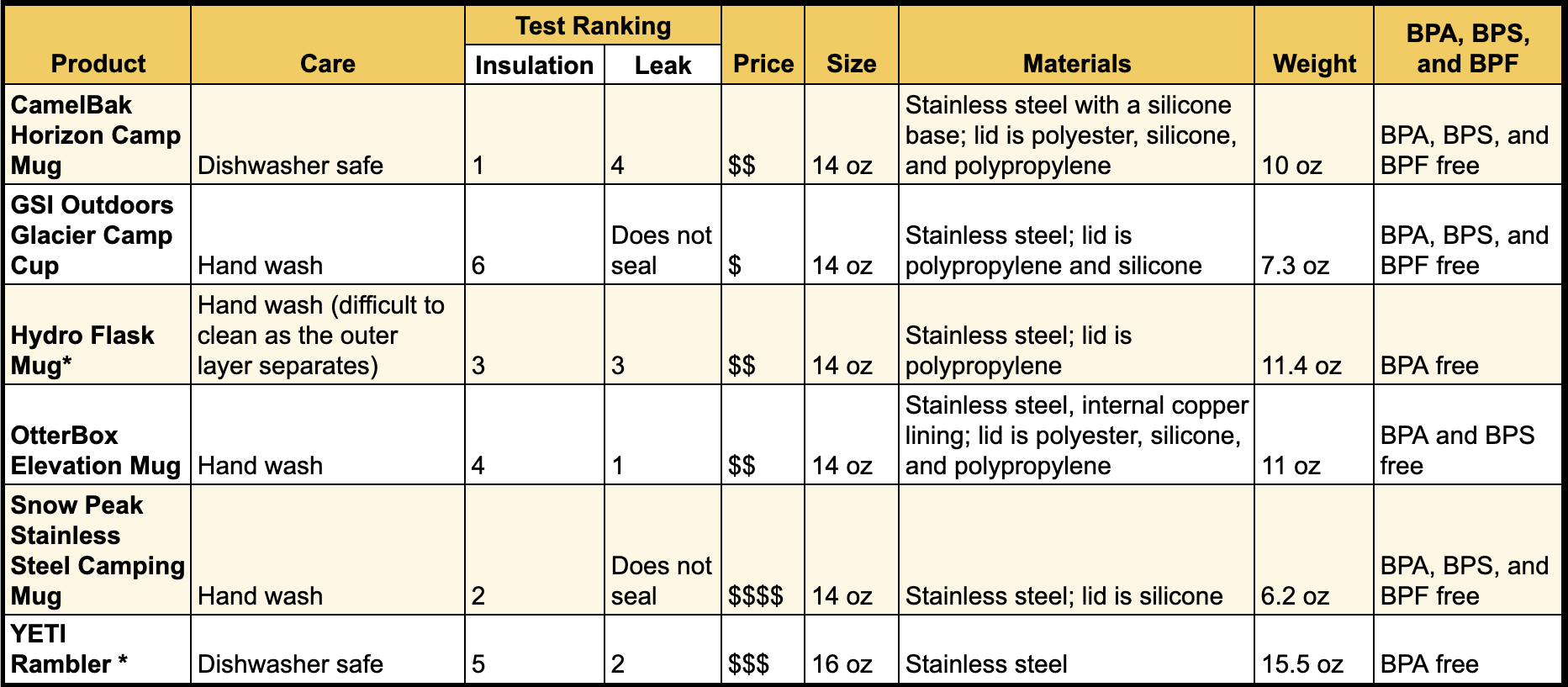
Best Overall: OtterBox Elevation
Key Features
- Size: 14 ounces
- Weight: 11 ounces
- Ice cube test: 3 hours, 45 minutes
- Materials: Stainless steel with internal copper lining; lid is made from polyester, silicone, and polypropylene
- BPA and BPS free
- Hand wash
Why It Made the Cut
The unique lid design of the Elevation made this my favorite mug to use in the field. This camping mug also did the best job at preventing leaks during testing.
Pros
- Tall rim around the lid made it easy to sip hot liquids
- Lid locks in place securely, minimizing spills and drips
- Bottom-heavy design makes it hard to accidentally tip over
Cons
- Middle of the road insulator during testing
Product Description
The problem with double-wall vacuum-sealed camping mugs is that sometimes they do their job a little too well, keeping coffee at a blistering temperature well after I would have expected it to cool off. So while I didn’t think much of the centimeter-tall rim of the OtterBox Elevation’s lid while running the insulation, weight, and leak tests, it’s what stood out to me most during the field test, when taking a tentative first taste to see if my coffee was cool enough to drink yet. The longer rim made it easy to take a slower sip, so that the outside air was cooling the hot coffee before it hit my mouth.
The OtterBox also performed well during the rest of testing. It was only 40 minutes behind the winner of the insulation test, and did a better job at preventing leaks and spills in the leak test than everything else I tested. When held at a 90-degree angle for 5 seconds, only three drops escaped from the seam between the mug and the lid.
Despite its middle-of-the-pack performance during the insulation test, my coffee never got cold during the field test—in part because the comfort, seal, and security of this mug made me actually want to drink from it. However, if you know that you are likely to be stipping on a single cup of coffee all morning, the CamelBak Horizon—the best insulator in my test—may be a better choice for you.
Best Insulation: CamelBak Horizon Camp Mug
Key Features
- Manufacturer size: 12 ounces; measured size: 14 ounces
- Weight: 10 ounces
- Ice cube test: 4 hours, 25 minutes
- Materials: Stainless steel with a silicon base
- BPA, BPS, and BPF free
- Dishwasher safe
Why It Made the Cut
The winner of the insulation test was what kept my coffee hot on the coldest day of field testing. Easy cleanup and a lack of bisphenols makes the CamelBak Horizon a no-brainer for long-term use.
Pros
- Excellent insulation
- Easy cleanup
- Silicone base makes it less likely to slip
Cons
- Tab on the lid bumped our nose uncomfortably during field testing
Product Description
The CamelBak Horizon was a close second for best camping mug—it kept my coffee plenty hot when it was 35 degrees and raining on the last morning of the field test, and the silicone base made it less likely to slide on smooth surfaces (although, as the narrowest camping mug in my test—including a slight narrowing at the base—it was more prone to tipping over than others I tried). It was also slightly lighter than other similarly designed camping mugs, making it a reasonable choice for short backpacking trips.
While the CamelBak Horizon’s slide tab lid design, which bumped my nose with each sip, was distracting, its profile was somewhat flatter than other similar models (such as the YETI Rambler).
Best Minimalist: Snow Peak Stainless Steel Camping Mug
Key Features
- Manufacture size: 15.2 ounces; measured size: 14 ounces
- Manufacturer weight: 6.06 ounces; measured weight: 6.2 ounces
- Ice cube test: 4 hours, 20 minutes
- Materials: Stainless steel; lid is silicone
- BPA, BPS, and BPF free
- Hand wash
Why It Made the Cut
This ultra lightweight camping mug was an insulating powerhouse, just barely coming in second in my test. Its trim design makes it an excellent choice for both car camping and backpacking.
Pros
- Great insulator
- Handles fold in for easy storage
- Comfortable to drink from
Cons
- Expensive
Product Description
I was surprised when the Snow Peak camping mug came in second on the insulation test, as there isn’t a tab or other feature to block heat from escaping (or entering, in the case of the ice cube test) through the sipping hole in the Snow Peak silicone lid. Further, it’s about half the weight of most of the camping mugs that were tested. If we were measuring insulation by weight, this one would have been far and away the winner.
At first glance, this stainless steel mug has a UL aesthetic (and, no surprise here, Snow Peak does sell a titanium version that saves half an ounce for the gram counters). It even has the traditional folding handle design, although I was pleased to see this perform on par with the rest of the handles during the field test, staying securely in place without sliding. For anyone willing to pay a premium for a camping mug that will function equally well on longer backpacking trips, this is a great choice.
Best Budget: GSI Outdoors Glacier Camp Cup
Key Features
- Manufacturer size: 15 ounces; measured size: 14 ounces
- Weight: 7.3 ounces
- Ice cube test: 2 hours, 20 minutes
- Materials: Stainless steel; lid is polypropylene and silicone
- BPA, BPS, and BPF free
- Hand wash
Why It Made the Cut
While the GSI Glacier didn’t perform at the same level as the other mugs in our review, its lower price point and lightweight design would be a great fit for warm-weather camping trips.
Pros
- Comparatively low price
- Lightweight
- Classic design that looks great with enamelware
Cons
- Last in the insulation test
Product Description
Given that this GSI Outdoors camping mug doesn’t have a fully-insulated lid, it wasn’t exactly surprising that it came in last in the insulation test. What was surprising is that it performed as well as it did, keeping an ice cube from melting for noticeably longer than the control. I used this mug on the warmest morning (when temps peaked around 45 degrees) of the testing trip and found that it was sufficiently insulated for that purpose, keeping my coffee warm until the last few sips. For warm weather trips, especially if multiple mugs are needed for a larger group, this is a great choice to keep costs down while still getting the performance you need.
Read Next: The Best Camping Coffee Makers of 2023
FAQs
Double-wall camping mugs, which will both insulate your beverages and protect your hands from the heat or cold of your beverage, typically cost between $15 and $30.
Enamel cups are a popular choice for camping because they are aesthetically pleasing, and can usually be bought as a set with plates and bowls. The downside to enamel cups is that they can chip (although not shatter), and they will not hold their temperature as well as a double-walled camping mug.
Titanium mugs are extremely popular, particularly with lightweight backpackers, as they weigh less than their stainless steel counterparts. However, titanium mugs are rarely double walled (as this adds weight), and tend to be significantly more expensive.
Things to Consider Before Buying a Camping Mug
Lid
Great camping mug lids share three traits: they are comfortable to drink from, they don’t leak or spill when tipped or shaken, and they help to insulate the contents of the mug itself.
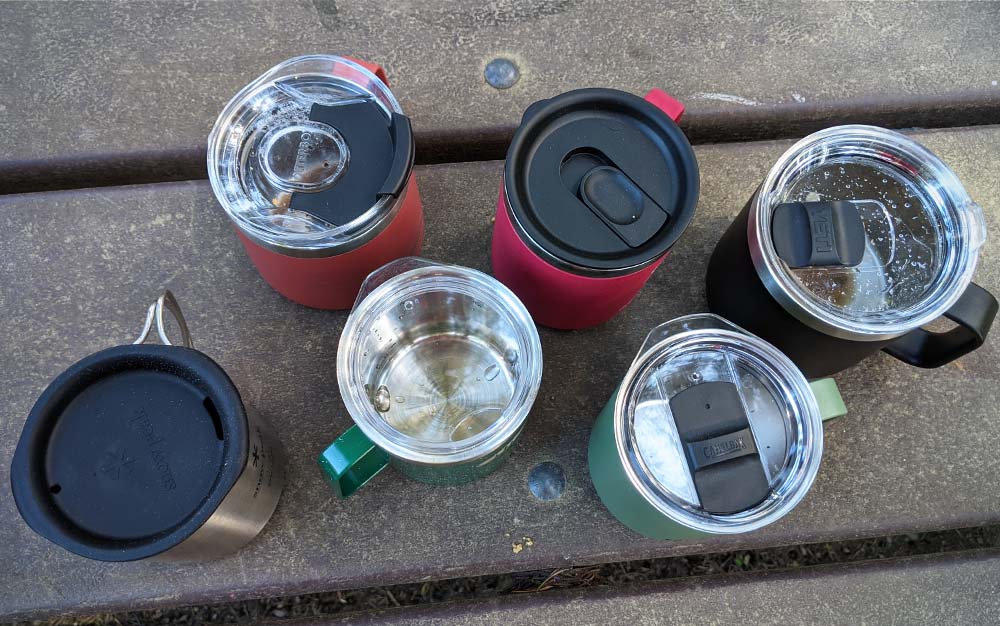
Insulation
All the camping mugs in this review are double-walled and vacuum-insulated, which more effectively insulates hot or cold beverages than single-wall mugs. In a double-wall-insulated design, the heat, or cold, from the mug must first transfer to the air in between the two walls before escaping to the outside. Vacuum-insulated designs take this one step further, sucking the air out from in between the two walls, further slowing down the transfer of heat.
BPA, BPS, and BPF
BPA, or bisphenol A, is a chemical found in certain plastics and resins. Materials with BPA have been found to seep into food and liquids when used for that purpose. This is a concern for many, as BPA is known to negatively affect the brain and prostate glands of children, infants, and even fetuses. There may also be a connection with increased blood pressure, type 2 diabetes, and heart disease.
There has been a push to eliminate BPAs in products used for food and beverages. Two compounds that are sometimes used instead of BPA are BPS (bisphenol S) and BPF (bisphenol F). While studies are still being conducted on the long-term effects of these compounds, there is concern that they may present health risks equal to, or even greater than, that of BPA.
Weight
The weight of an individual camping mug is unlikely to be an issue for most car campers, as they typically weigh about as much as a standard glazed ceramic mug. However, if you also plan to use your camping mug for backpacking, it’s worth looking for a lightweight option, like the Snow Peak Stainless Steel Camping Mug or GSI Outdoors Glacier Camp Cup.
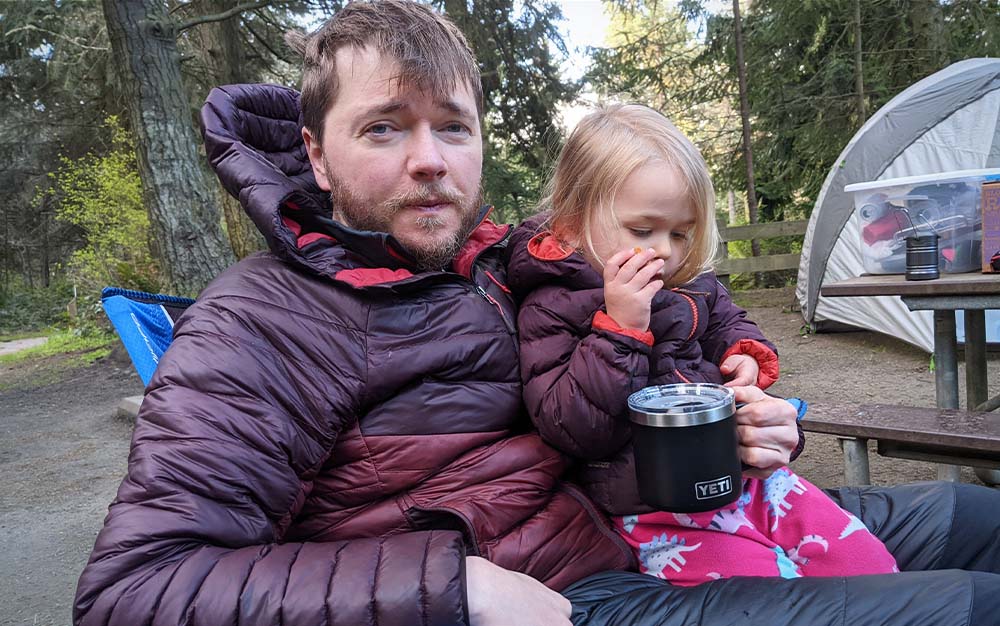
Final Thoughts
On frosty mornings, a great camping mug can be a game changer: keeping your morning beverage—and by extension, you—warm until the sun at last peaks out from over the ridge. Adding one of the above mugs to your mess kit is a simple way to make a big difference to your outdoor experience.
